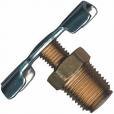Look in my avatar to see my 1981 Grandma Bear fisher wood stove. Been in service every year since install and is a general workhorse (I mean, what is there to fail).
In an attempt to save the environment and perhaps get some more heat out of less wood, I designed a baffle that a friend in a metal shop made up for me. Last night I was able to cut firebrick to fit, and install.
Here is what it looks like now. Before there was nothing stopping the flames from going directly up the chimney!
The entire thing is made out of 3/16 thick angle iron (doubled down the center). Hopefully it will withstand the heat over time.

The opening now that allows the gasses to enter into the top chamber of the stove is just slightly larger in area than the area of the 8in flue pipe exit.
It is pretty early in testing, but the first day seems to be good.
So far I am noticing that my stove surface temps are staying as high as normal for longer and on less wood.
I am also seeing my chimney pipe temperatures running lower than normal.
It will be an adjustment period as I learn whether or not it is better to leave the damper on the stove pipe wide open now, or close it some and increase my primary air intakes to maintain a sufficient flue temperature. Guess I'll be making the neighbors wonder what I am up to again by making 50+ trips out on the deck to see if smoke is coming out of the chimney.
I am going to clean the chimney today once the stove burns out later this morning so I can start on a clean chimney and see if this will change (for the better or worse) my chimney cleanliness.
This definitely is not as efficient as a secondary system, but hopefully will prove to keep the smoke down in the heat a bit longer and perhaps result in a bit more heat and cleaner burns.
My only concern is that perhaps the extra heat that is kept down on the wood because of this baffle may cause the wood to pyrolize and there may not be enough air present to sufficiently burn it. If this is the case, I am hoping that by reducing the stack damper I can increase primary air to aid with this. However, utilizing the stack damper also slows the speed of the effluent, giving it a better chance to reduce as creosote. If this is a problem, I could even remove a firebrick from the front of this, back, both, who knows.
Sooo, it may be of help, or not. But the way it is designed it can be easily removed.
Let the experimentation continue!
pen
In an attempt to save the environment and perhaps get some more heat out of less wood, I designed a baffle that a friend in a metal shop made up for me. Last night I was able to cut firebrick to fit, and install.
Here is what it looks like now. Before there was nothing stopping the flames from going directly up the chimney!
The entire thing is made out of 3/16 thick angle iron (doubled down the center). Hopefully it will withstand the heat over time.
The opening now that allows the gasses to enter into the top chamber of the stove is just slightly larger in area than the area of the 8in flue pipe exit.
It is pretty early in testing, but the first day seems to be good.
So far I am noticing that my stove surface temps are staying as high as normal for longer and on less wood.
I am also seeing my chimney pipe temperatures running lower than normal.
It will be an adjustment period as I learn whether or not it is better to leave the damper on the stove pipe wide open now, or close it some and increase my primary air intakes to maintain a sufficient flue temperature. Guess I'll be making the neighbors wonder what I am up to again by making 50+ trips out on the deck to see if smoke is coming out of the chimney.
I am going to clean the chimney today once the stove burns out later this morning so I can start on a clean chimney and see if this will change (for the better or worse) my chimney cleanliness.
This definitely is not as efficient as a secondary system, but hopefully will prove to keep the smoke down in the heat a bit longer and perhaps result in a bit more heat and cleaner burns.
My only concern is that perhaps the extra heat that is kept down on the wood because of this baffle may cause the wood to pyrolize and there may not be enough air present to sufficiently burn it. If this is the case, I am hoping that by reducing the stack damper I can increase primary air to aid with this. However, utilizing the stack damper also slows the speed of the effluent, giving it a better chance to reduce as creosote. If this is a problem, I could even remove a firebrick from the front of this, back, both, who knows.
Sooo, it may be of help, or not. But the way it is designed it can be easily removed.
Let the experimentation continue!
pen


 In time I suppose. Just hard putting a drill to a stove that I love even if I intellectually know the results.
In time I suppose. Just hard putting a drill to a stove that I love even if I intellectually know the results.